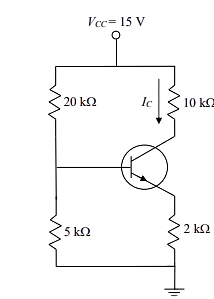A transistor (β=100, 𝑉𝐵𝐸 = 0.7𝑉) is connected as shown in the circuit below.

The current IC will be mA. (Rounded off to two decimal places)

The current IC will be mA. (Rounded off to two decimal places)
Correct Answer: 1.1
Solution and Explanation
Steps to Calculate \( I_C \)
Step 1: Voltage at the Base (\( V_B \))
The base voltage \( V_B \) is determined by the voltage divider formed by the 20kΩ and 5kΩ resistors:
\[ V_B = V_{CC} \cdot \frac{5k\Omega}{20k\Omega + 5k\Omega} \]
Substituting \( V_{CC} = 15V \):
\[ V_B = 15 \cdot \frac{5}{25} \]
\[ V_B = 3.0V \]
Step 2: Voltage at the Emitter (\( V_E \))
The emitter voltage \( V_E \) is related to the base voltage by:
\[ V_E = V_B - V_{BE} \]
Substituting \( V_{BE} = 0.7V \):
\[ V_E = 3.0 - 0.7 = 2.3V \]
Step 3: Emitter Current (\( I_E \))
The emitter current \( I_E \) is determined by the 2kΩ resistor:
\[ I_E = \frac{V_E}{2k\Omega} \]
Substituting \( V_E = 2.3V \):
\[ I_E = \frac{2.3}{2000} \]
\[ I_E = 1.15mA \]
Step 4: Collector Current (\( I_C \))
The collector current \( I_C \) is related to the emitter current \( I_E \) by:
\[ I_C = \frac{\beta}{\beta + 1} I_E \]
Substituting \( \beta = 100 \):
\[ I_C = \frac{100}{101} \times 1.15 \]
\[ I_C \approx 1.14mA \]
Final Answer
Thus, the collector current \( I_C \) is approximately 1.14mA.
Top Questions on Solid State Physics, Devices, Electronics
- Draw the energy-band diagram for conductors, semiconductors, and insulators at T = 0 K. How is an electron-hole pair formed in a semiconductor at room temperature?
- CBSE CLASS XII - 2025
- Physics
- Solid State Physics, Devices, Electronics
- The first maxima for Bragg's diffraction pattern by a crystal is observed at 30\(^{\circ}\) when X-rays wavelength of 0.32 nm are used. The distance between the atomic planes is:
- CUET (PG) - 2025
- Physics
- Solid State Physics, Devices, Electronics
- The lattice constant of a simple cubic lattice having interplanar spacing 3\AA{ for (002) plane is:}
- CUET (PG) - 2025
- Physics
- Solid State Physics, Devices, Electronics
- Brillouin zone is:
A. Wigner-Seitz cell of reciprocal lattice
B. Primitive unit cell
C. The locus of all k-values in the reciprocal lattice which are Bragg reflected.
D. Wigner-Seitz cell of direct lattice
The correct statements are:- CUET (PG) - 2025
- Physics
- Solid State Physics, Devices, Electronics
- Arrange the following crystal structures in ascending order of their coordination number.
A. Diamond
B. Sodium Chloride
C. Cesium Chloride
D. Zinc with hexagonal closed packed structure
Choose the CORRECT answer from the options given below:- CUET (PG) - 2025
- Physics
- Solid State Physics, Devices, Electronics
Questions Asked in IIT JAM exam
- For a Zener diode as shown in the circuit diagram below, the Zener voltage \(V_Z\) is 3.7 V. For a load resistance (\(R_L\)) of 1 k\(\Omega\), a current \(I_1\) flows through the load. If \(R_L\) is decreased to 500 \(\Omega\), the current changes to \(I_2\). The ratio \(\frac{I_2}{I_1}\) is \rule{1cm{0.15mm}. (up to two decimal places)}

- IIT JAM PH - 2025
- Analog Electronics
- The shortest distance between an object and its real image formed by a thin convex lens of focal length 20 cm is _____ cm. (in integer)
- If \(\left(\frac{1-i}{1+i}\right)^{n/2} = -1\), where \(i = \sqrt{-1}\), one possible value of n is
- IIT JAM PH - 2025
- Complex numbers
- In a two-level atomic system, the excited state is 0.2 eV above the ground state. Considering the Maxwell-Boltzmann distribution, the temperature at which 2% of the atoms will be in the excited state is _____ K. (up to two decimal places)
(Boltzmann constant \(k_B = 8.62 \times 10^{-5}\) eV/K)
- IIT JAM PH - 2025
- Mechanics
At a particular temperature T, Planck's energy density of black body radiation in terms of frequency is \(\rho_T(\nu) = 8 \times 10^{-18} \text{ J/m}^3 \text{ Hz}^{-1}\) at \(\nu = 3 \times 10^{14}\) Hz. Then Planck's energy density \(\rho_T(\lambda)\) at the corresponding wavelength (\(\lambda\)) has the value \rule{1cm}{0.15mm} \(\times 10^2 \text{ J/m}^4\). (in integer)
[Speed of light \(c = 3 \times 10^8\) m/s]
(Note: The unit for \(\rho_T(\nu)\) in the original problem was given as J/m³, which is dimensionally incorrect for a spectral density. The correct unit J/(m³·Hz) or J·s/m³ is used here for the solution.)- IIT JAM PH - 2025
- Mechanics